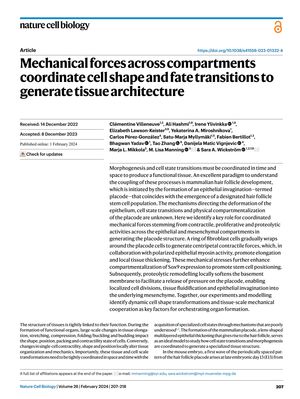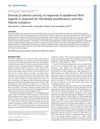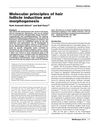Mechanical Forces Across Compartments Coordinate Cell Shape and Fate Transitions to Generate Tissue Architecture
February 2024
in “
Nature cell biology
”
hair follicle placodes mechanical forces contractile activities proliferative activities proteolytic activities epithelial compartments mesenchymal compartments polarized myosin activity fibroblast contractions matrix metalloproteinases basement membrane remodeling tissue fluidification placode invagination cell-autonomous forces extrinsic contractile forces Myh9 gene myosin-IIA hair follicle myosin fibroblasts MMPs

TLDR Mechanical forces are crucial for shaping cells and forming tissues during development.
This document summarizes a series of studies that explore the role of mechanical forces in the development of hair follicle placodes in mice. The studies demonstrate that coordinated mechanical forces from contractile, proliferative, and proteolytic activities across epithelial and mesenchymal compartments are essential for placode formation. Key findings include the necessity of polarized myosin activity and fibroblast contractions for tissue thickening, and the role of matrix metalloproteinases in basement membrane remodeling for pressure release and tissue fluidification, leading to placode invagination. The research shows that both cell-autonomous and extrinsic contractile forces are required for proper placode formation, with extrinsic forces being more significant at later stages. The deletion of the Myh9 gene, which encodes for myosin-IIA, in fibroblasts resulted in fewer and less developed placodes, highlighting the importance of myosin activity. The studies involved multiple placodes from several mice, with specific numbers varying for different experiments, and utilized various statistical tests for quantitative analyses. The findings suggest that similar mechanical crosstalk mechanisms may be involved in other developmental processes and diseases.






